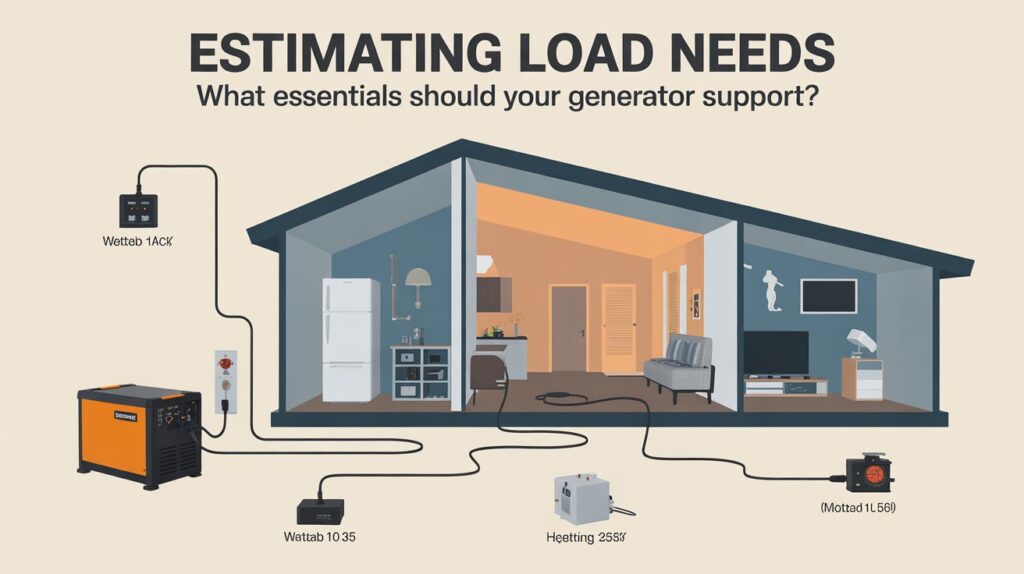When power outages occur, the ability to maintain essential functions at home or work depends on reliable backup power. Estimating load needs before an emergency makes the difference between uninterrupted comfort and unplanned disruptions. Home generators provide dependable support, but only if they are matched correctly to the demands placed on them.
Understanding which appliances and systems require power, how much energy they consume, and how to balance usage ensures that a generator operates safely and effectively. The following sections explain why load estimation matters, how to identify essentials, and how to calculate the power requirements of key systems.
Why Load Estimation Matters
Accurate load estimation is the foundation of reliable generator use. Without it, there is a risk of overloading the system, which can damage both the generator and the appliances it powers. Overestimation can be equally problematic, leading to unnecessary investment in a generator that far exceeds actual needs.
Proper planning guarantees that critical devices receive consistent power without interruptions, while less essential items can be managed separately. Load estimation also reduces safety hazards, such as overheating or equipment failure, that come with misuse. Ultimately, knowing the required load allows owners to select the right generator size, extend the life of their equipment, and maintain reliable performance during outages.
Identifying Essential Appliances and Systems
The first step in load planning is identifying which appliances and systems are truly essential during an outage. In most households, refrigeration is critical to prevent food spoilage, while heating or cooling systems are necessary for maintaining safe indoor temperatures.
Communication tools, such as routers or phone chargers, also become priorities in keeping families connected. For some households, medical devices that require continuous operation are non-negotiable.
By distinguishing essentials from non-essentials, it is easier to determine the appropriate generator size and prevent unnecessary strain. This process makes sure that backup power supports health, safety, and continuity rather than being stretched across appliances that can remain unused.
Calculating Wattage Requirements
Once the essentials are identified, the next step is calculating how much power they require. Every appliance has two types of power demands: running watts, which reflect normal operation, and starting watts, which account for the surge of energy needed when the appliance turns on. For example, refrigerators and air conditioners often require significantly more power at startup than during continuous use.
Failing to account for starting watts can cause a generator to shut down or overload unexpectedly. Creating an organized list of each appliance, with both running and starting wattage clearly noted, prevents miscalculations. Adding these numbers together provides a clearer picture of the total demand, making it possible to select a generator that consistently delivers the required output.
Balancing Power Supply and Demand
Having accurate wattage estimates is only part of effective planning managing how power is distributed is equally important. A generator must not be pushed to its maximum capacity at all times, as this shortens its lifespan and increases the risk of failure.
Balancing supply and demand involves running only the most essential appliances simultaneously, while cycling others when needed. For instance, larger loads like air conditioners can be alternated with smaller devices to maintain balance. Staggering usage ensures steady performance and avoids sudden spikes in demand.
This approach also improves efficiency, allowing the generator to operate within safe limits. By carefully balancing demand with capacity, households and businesses maintain both reliability and safety during extended outages.
Planning for Growth and Unexpected Needs
Load estimation should not be viewed as a one-time calculation but rather as a flexible process. Needs can change over time, whether through the addition of new appliances, upgraded systems, or changing household priorities.
Leaving extra capacity ensures that a generator is not operating at its limits and can accommodate future growth. It also prepares for unexpected situations during an outage, such as needing to power a temporary heating unit or additional communication devices.
Planning for these contingencies prevents overload and guarantees that critical systems continue running smoothly, even when demand increases suddenly. By building in this margin, generator users gain confidence that their system can handle both present and future requirements.
Powering Essentials with Confidence
Estimating load needs is one of the most important steps in preparing for reliable backup power. By carefully identifying essential systems, calculating wattage requirements, balancing supply and demand, and planning for growth, households and businesses can make sure their generators operate effectively when outages occur.
Proper load planning prevents equipment damage and safety risks and also provides peace of mind that critical systems will remain powered. Generators are most valuable when they are matched to the needs they support, and load estimation makes that possible.

